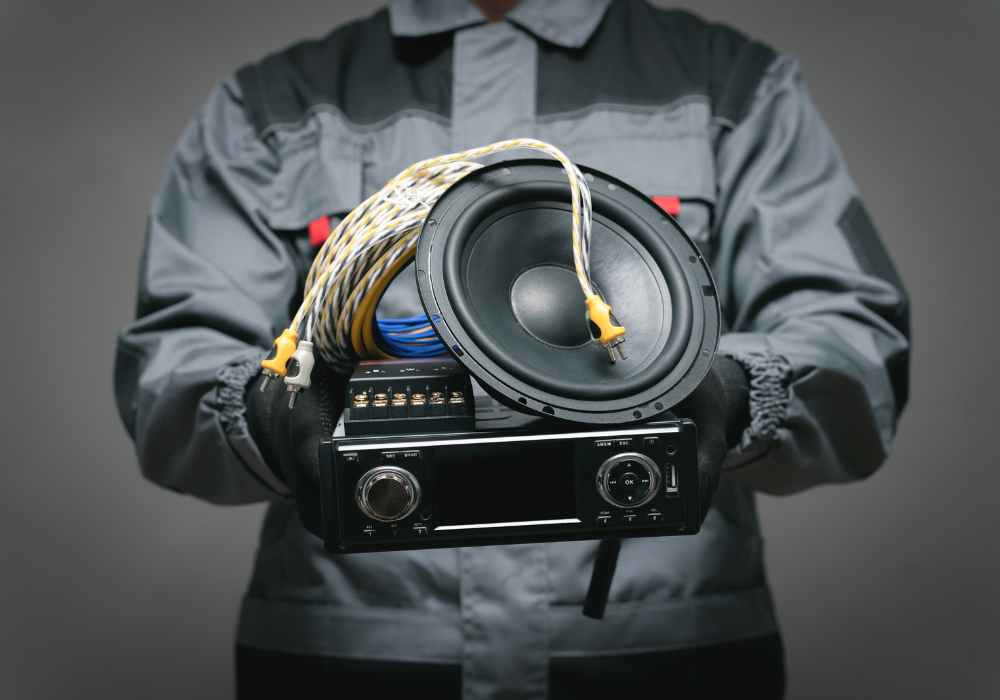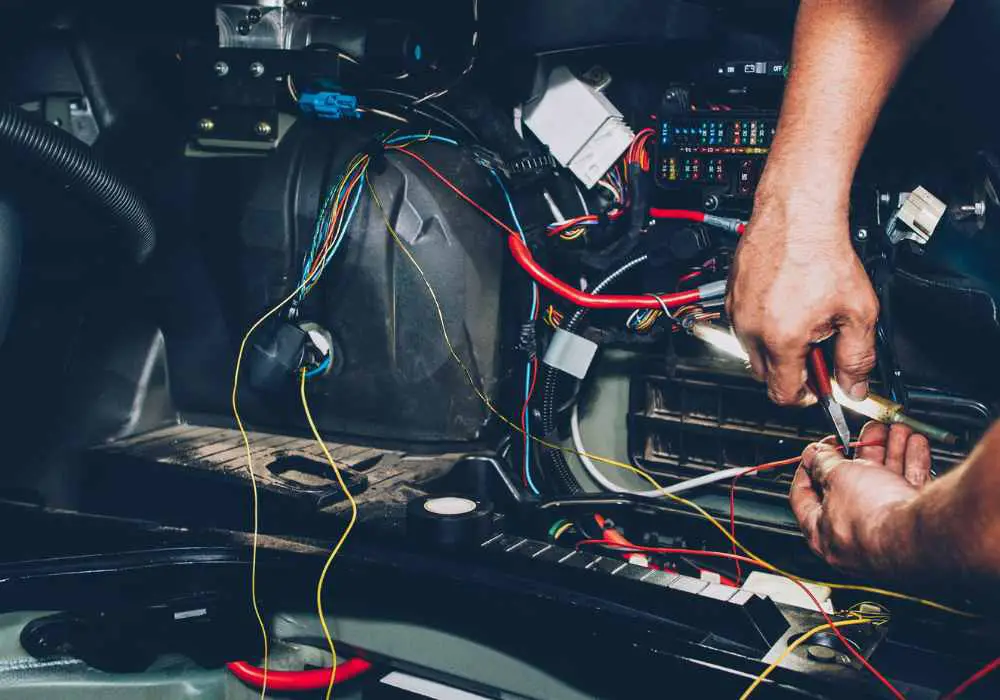If you’ve installed an aftermarket stereo in your car and it won’t turn off when the car is turned off, you’re likely experiencing a frustrating and potentially dangerous issue.
Not only can a faulty aftermarket stereo drain your car’s battery, but it can also cause problems with your car’s electrical system.

In this article, we’ll outline the possible causes of this problem and provide detailed explanations for how to diagnose and fix it.
Possible causes of the problem
There are several possible causes for an aftermarket stereo that won’t turn off when the car is turned off. Some of the most common include:
Incorrect installation of the aftermarket stereo:
If the aftermarket stereo was not installed correctly, it may not function properly. For example, if the wiring was not connected correctly, the stereo may not turn off when the car is turned off.
It’s important to follow the manufacturer’s instructions and use high-quality parts when installing an aftermarket stereo to ensure proper function.
Defective wiring or connections:
If the wiring or connections between the aftermarket stereo and the car’s electrical system are defective, the stereo may not turn off when the car is turned off.
Wiring can become damaged or loose over time, so it’s important to regularly inspect the wiring and connections for any issues.
Special attention should also be paid to the wiring that connects the aftermarket stereo to the car’s electrical system.
Faulty aftermarket stereo unit:
In some cases, the aftermarket stereo itself may be defective and not function properly. This can be due to a variety of factors, including manufacturing defects or wear and tear.
The most common reason behind this issue on a good stereo is a software glitch that is preventing the stereo from turning off. This can be resolved by resetting the stereo or performing a software update.
Problem with the car’s electrical system:
If there is an issue with the car’s electrical system, it could cause problems with the aftermarket stereo and prevent it from turning off when the car is turned off. This can be due to a variety of factors, including a faulty battery, alternator, or other electrical components.
This requires special attention in case you have performed the installation of the aftermarket stereo yourself or if you have recently tempered with any wiring or things related to it.
Diagnosing the problem
To accurately diagnose the problem with your aftermarket stereo, it’s important to follow a systematic process to narrow down the possible causes. Here are some steps you can take:
Check the installation:
Make sure that the aftermarket stereo was installed correctly, including all wiring connections.
Look for any loose or improperly connected wires, and check that all connections are secure.
Test the wiring:
Using a wiring diagram for your car and aftermarket stereo, check for any loose or damaged wiring. You can use a multimeter to test for continuity and ensure that the wiring is functioning properly.
Test the aftermarket stereo unit:
If the wiring appears to be in good condition, try replacing the aftermarket stereo unit to see if that fixes the problem.
If the problem persists with a new unit, it’s likely that there is an issue with the car’s electrical system.
Check the car’s electrical system:
If the above steps do not solve the problem, there may be an issue with the car’s electrical system.
You may need to consult a mechanic or auto electrician to diagnose and fix this problem. They can perform a diagnostic test on the car’s electrical system to identify any issues and determine the best course of action.

It’s important to thoroughly diagnose the problem to ensure that you are accurately fixing the issue and preventing further problems. Ignoring the issue or attempting to fix it without a thorough diagnosis can lead to further problems and potentially costly repairs.
If you are not comfortable with performing these steps yourself, it is always a good idea to seek the help of a professional mechanic or auto electrician.
Solutions for each possible cause:
Once you’ve accurately diagnosed the cause of the problem, you can take the following steps to fix it:
Incorrect installation of the aftermarket stereo:
If the aftermarket stereo was not installed correctly, the best solution is to re-install it correctly following the manufacturer’s instructions and using good quality wires and connectors.
Here’s a step-by-step guide for re-installing an aftermarket stereo:
- Disconnect the negative terminal of the car’s battery to avoid any electrical accidents.
- Remove the dashboard panel or center console to access the stereo.
- Carefully remove the stereo, being mindful of any wiring connections.
- Connect the wiring harness of the stereo to the wiring harness of the car, matching the colors of the wires. Carefully connect everything so that you do it right this time.
- Double-check everything to see if everything is in proper order as per the user manual.
- Secure the stereo in place, making sure it is properly secured.
- Replace the dashboard panel or center console.
- Reconnect the negative terminal of the car’s battery.
Defective wiring or connections:
If the wiring or connections between the aftermarket stereo and the car’s electrical system are defective, you’ll need to repair or replace the faulty wiring. This may require the help of a mechanic or auto electrician.
Here’s a step-by-step guide for repairing or replacing faulty wiring:
- Disconnect the negative terminal of the car’s battery to avoid any electrical accidents.
- Locate the faulty wiring or connections.
- If the wiring is damaged, cut out the damaged section and splice in a new piece of wire using wire connectors.
- If the connections are loose, tighten them or use wire connectors to secure them.
- Test the wiring to ensure it is functioning properly.
- Reconnect the negative terminal of the car’s battery.
Faulty aftermarket stereo unit:
If the aftermarket stereo unit itself is faulty, the best solution is to replace it with a new unit.
Make sure to purchase a high-quality unit from a reputable manufacturer to avoid future problems.
Here’s a step-by-step guide for replacing a faulty aftermarket stereo unit:
- Disconnect the negative terminal of the car’s battery to avoid any electrical accidents.
- Remove the dashboard panel or center console to access the stereo.
- Carefully remove the faulty aftermarket stereo, being mindful of any wiring connections.
- Connect the wiring harness of the new aftermarket stereo to the wiring harness of the car, matching the colors of the wires.
- Secure the new aftermarket stereo in place, making sure it is properly secured.
- Replace the dashboard panel or center console.
- Reconnect the negative terminal of the car’s battery.
Problem with the car’s electrical system:
If there is an issue with the car’s electrical system, it’s important to diagnose and fix the problem to prevent further issues with the aftermarket stereo and other electrical components in the car.
This may require the help of a mechanic or auto electrician. They can perform a diagnostic test on the car’s electrical system to identify any issues and determine the best course of action.
Point to be Noted
It’s important to follow the manufacturer’s instructions and use high-quality parts when performing any repairs or replacements. This can help ensure the longevity and reliability of the aftermarket stereo and the car’s electrical system.
If you are not comfortable with performing these repairs or replacements yourself, we recommend seeking the help of a professional. They can perform these repairs and replacements safely and correctly, so you don’t have to worry about any potential accidents or damages.
Preventing future problems with the aftermarket stereo:
To prevent future problems with your aftermarket stereo, it’s important to follow these tips:
- Properly install the aftermarket stereo according to the manufacturer’s instructions and using high-quality parts.
- Regularly inspect and maintain the wiring and connections between the aftermarket stereo and the car’s electrical system.
- Purchase a high-quality aftermarket stereo unit from a reputable manufacturer to ensure reliable performance.
- Follow the manufacturer’s instructions for proper use and maintenance of the aftermarket stereo.
Conclusion:
If your aftermarket stereo won’t turn off when the car is turned off, there are several possible causes and solutions.
It’s important to thoroughly diagnose the problem to ensure that you accurately fix the issue and prevent further problems.
By following the tips outlined in this article and using high-quality parts and following the manufacturer’s instructions, you can help ensure that your aftermarket stereo functions properly and reliably.
